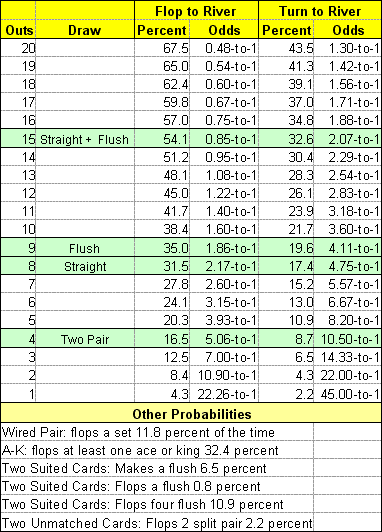Poker Odds Flush Draw On Flop
- Poker Odds Flush Draw On Flop Game
- Poker Odds Flush Draw After Flop
- Poker Odds Flush Draw On Flop Chart
You will have 9 outs to hit a flush on the flop or turn if you have a flush draw. From flop to the river, we have 9 outs twice to hit a flush, which is roughly 38%, from turn to the river we have about 18% (9 outs once). On the other hand, if you hold an open-ended straight draw, you will have only 8 outs to hit it. However, a “gutshot” straight draw (i.e. Four outs such as 7-8 on a 4-5-X flop) generally does not have a good chance of winning and should be played only in very specific conditions. A straight isn't as strong as a flush, meaning that you will sometimes hit your straight but still lose against a better hand such as a flush or a full house. Three fewer outs: The flush draw to beware of is where you have no extra outs, just the nine cards for your flush. The magic formula tells us that your chances then are just 9 x 4 = 36%, ie 1 in 3. It’s a big leak in less experienced players’ strategy to chase this kind of flush draw against a single opponent. Hold'em after Flop Odds for Common Draw Hands. About everyone knows the term 'ballpark' as used with estimates etc. For those that don't, it's just a colorful substitute for the term 'approximate' which sounds like an excuse for a lack of accuracy. The purpose for this page is to present an easy to remember guide that can be used at the tables. After the flop you've seen 4 cards of your suit, and 1 of another suit. This leaves 9 cards of your suit, and 38 of a different suit; your odds of completing your flush on the turn are thus 9/47, or 19.14%. If the turn hasn't completed your flush, your odds of completing it on the river are 9/46, or 19.5%.
About everyone knows the term 'ballpark' as used with estimates etc. For those that don't, it's just a colorful substitute for the term 'approximate' which sounds like an excuse for a lack of accuracy.
The purpose for this page is to present an easy to remember guide that can be used at the tables. The ballpark chances shown are rounded whole numbers used to make the 'odds against'. This approach assumes that a 'ballpark' 7 to 1 against is easier to remember than 6.73* to 1 or 12.94% percent to make.
* Note: Normal rounding example = 6.50 is rounded up to 7 and 6.49 is rounded down to 6.
For a detailed view of the chart (good for mobile or tablet users) or to print, check out holdem after flop odds in universal .pdf format.
Poker Odds Flush Draw On Flop Game
For those unfamiliar with outs, an 'out' is the term used in the after-flop betting rounds to describe any card among the unseen cards in the deck that can substantially improve the value of your hand on the next card turned up.

For example, if after the flop you happen to have a total of four hearts, then your hand has nine 'outs' because there are nine of the original thirteen hearts still left in the unseen remaining deck. A much weaker draw hand would be for example, an inside straight. This hand only has four outs because the only cards left in the deck that can complete the straight would be the four cards of the missing denomination.
Of course, the more outs you have the better chance you have of making a strong hand. This chart offers some extra ways to look at and evaluate those chances. All Texas Holdem hands have 47 unseen cards after the flop and 46 after the turn. The chart is nothing more than the number of outs and these two unseen cards amounts, expressed in different ways.
Poker Odds Flush Draw After Flop

Those on mobile devices or tablets may wish to view the holdem after flop outs odds chart in high quality .pdf format.
Poker Odds Flush Draw On Flop Chart
It might be interesting for you to note that when you double the number of outs, you get a number that is approximately the expected hit percentage of a single draw to your hand. For example, 8 outs equals about 16% (actually 17.02%) and 12 outs equals about 24% (actually 25.53%). You might find similar references or comparisons that you can use.



